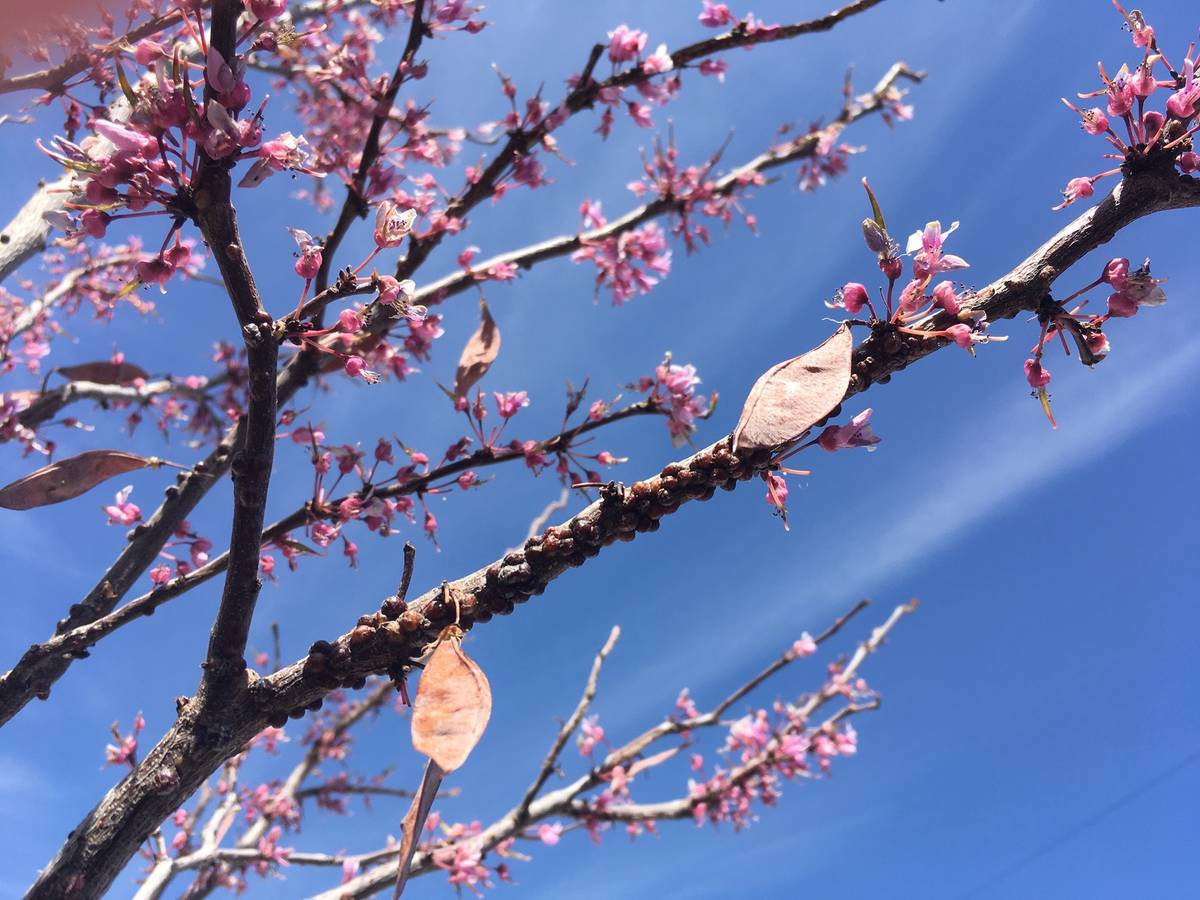Deciduous trees, shrubs drop leaves in cold temperatures
Most leaf drop of deciduous trees and shrubs occurs by mid-December. Some plants will start dropping leaves as early as the second week of November while others drop leaves later. But of course, much of that depends on the weather and tree health. If it’s unusually cold early, leaf drop is early. If cold weather is later, leaf drop is later. If it’s an unusually warm winter, some trees and shrubs that are partly deciduous (aka, partially evergreen) keep their leaves through the winter. By the way, plants listed as “evergreen” in the lower and warmer deserts of Arizona are not necessarily “evergreen” in the colder Las Vegas climate.
There are two things to think about this winter; major pruning jobs and applications of dormant oil. If you value a landscape tree, use a certified arborist or someone who has advanced training in tree pruning and care of landscape trees. You will get what you pay for.
Pruning shrubs is not that difficult but the final judge of whether a pruning job was done correctly is how the plant looks afterwards. The best pruning jobs leave plants looking as if nothing was done at all, unless “before” and “after” pictures are compared. Some less expensive landscape maintenance people will prune your trees but will not know how to do it correctly.
Last week, I spoke about insurance. Well, winter application of dormant oils. (horticultural oils) are your “insurance” against the onslaught of soft-bodied insects like aphids, whiteflies, mites, scale insects and others “overwinter” in the cracks, crevices and near the base of tree trunks, as well as nearby cold-weather weeds. Dormant oil application is probably the most important preventive pest control measure you can do for plants if these bugs were a problem in the past. But its insurance.
Dormant oil applications do nothing to prevent that ugly alien-looking leaf-footed plant bug that attacks pomegranate, apricot, almond and vegetables or controlling grubs that feed on plant roots. Winter applications of dormant oils will not control all insect pests in the landscape just some specific ones. But you will see a reduction of plant pest problems next year.
I’m sometimes asked if neem oil is a “dormant oil.” It’s not. Neem oil is plant-based. Horticultural oils are not. Horticultural oils serve a different purpose than neem oil. Neem oils have toxic properties that kill or repel many kinds of insects. It is a “contact” insecticide that lasts a little longer than “soap sprays.” But neem oil doesn’t stick around through the winter and suffocate insects like horticultural oils might. I use neem oil when I rotate between insecticidal soaps and other natural pesticides like Spinosad and BT. I have used horticultural oils to successfully control aphids a couple of weeks after flowering of peach, plum and apricot (but never while flowering).
Q. I’ve been trying to figure out what kind of apple is in my neighbor’s yard near Lone Mountain. The fruit is medium-sized, yellow, tart and sheep-nosed. Can you help me identify what variety it might be?
A. Since apples are not a mainstay in hot desert climates, it is probably an early yellow apple like Dorsett Golden or Anna varieties. These produce yellow apples in June here. There are maybe 800 varieties of apples available to grow well in apple-growing climates and maybe 25 or 30 of those that have yellow fruit. I have not had the best luck here with other yellow varieties like Ein Shemer or Winter Banana. All apples here are successfully grown on semi-dwarfing rootstocks such as M111, which helps keep the tree smaller.
Apples are tough to grow in the desert and there are only a few varieties that perform well. Most of the best apples grown here produce fruit either early (June) or late from mid-September through mid-December and before it freezes.
Q. I recently had my front and rear yards converted to water smart landscaping, no grass. This is mostly rock with desert plants. Can you recommend a pre-emergent weed control product that I can use instead of spending my spring pulling weeds?
A. If you put down a thick enough mulch (rock or woodchips) then annual weeds are stopped. This mulch keeps the soil surface dark, and the mulch is too thick to allow only the most vigorous weeds to make it. Except for Bermuda grass, perennial nightshade and nutgrass a 4-inch layer of any type of surface mulch applied deep enough prevents most weeds from coming up.
If the weed problem is still a mess and it is a grass (like Bermuda grass), then use Fusilade (fluazifop-p-butyl listed in the active ingredients). Fusilade doesn’t hurt flowers, trees or shrubs. It only kills the grass if applied at labelled rates. It can act as a substitute for Roundup as far as grass control goes. But unlike Roundup, you can spray right over the top of annual flowers if it is infested with Bermuda grass.
I use a “fire weeder” to burn off the tops of annual weeds in the spring if local ordinances permit it. A couple of passes, two weeks apart, gets most of them. You can use chemicals like Diquat to “burn off” the tops after they first come up. Just don’t let annual weeds go to seed. Professionals spot spray with a combination of Roundup and Surflan pre-emergent weed killer, along with a paint marker mixed in the spray, to get both winter annuals and spring annual weeds as well as identifying the spots already sprayed.
Q. A Mexican papaya volunteered in four of our pots. We did add compost to all the pots just before leaving. How can we winter it over on our sun porch? Any chance it will fruit for us?
A. To my knowledge, there is no such thing as a “Mexican papaya.” Most of the papaya available in local American grocery stores is grown in Mexico. So, someone perhaps named yours “Mexican papaya.” If you want to grow papaya in one season here, I suggest buying seed of a variety of papaya like Red Lady or Solo that produce fruit in nine months or less. Papaya is a little temperamental because it is tropical, so it requires some dedication and perseverance on your part.
All types of papaya have the same genus and species, Carica papaya. There are cultivars or varieties of papaya such as Red Lady, Solo, Maradol, Sunrise and others. Most likely the papaya, if the flesh is red, are varieties either Maradol, Sunrise or Caribbean Red, which are commonly grown in Mexico for export to the U.S. If it was orange or yellow fleshed, it might be any variety. Red-fleshed papaya is preferred for U.S. markets.
With unknown varieties they will flower when it is good and ready and that depends on the variety. Just keep it alive until then and put it on the east side of the home or wall when grown outside.
Q. I have a redbud tree and I think it has scale. Will these scale insects damage the tree?
A. Yes, they will. If scale insects get bad enough, they will weaken a tree and cause poor growth. Scale insects aren’t usually the cause of death, but they can contribute to it. If you have a redbud tree, inspect it for scale. If your redbud tree has stems with hard, quarter-inch raised roundish bumps that look out of place on its smooth stems, your tree probably has scale insects. The small roundish bumps seen on the branches are protective “houses” used for hiding while they suck on plant juices.
Scale insects are somewhat common on redbud and can spread slowly from tree to tree in the landscape or the nursery. The idea is to protect the new growth occurring in the spring and summer months by spraying it with horticultural oil. Spray these trees in the spring and early summer starting next spring.
Bob Morris is a horticulture expert and professor emeritus of the University of Nevada, Las Vegas. Visit his blog at xtremehorticulture.blogspot.com. Send questions to Extremehort@aol.com.






















